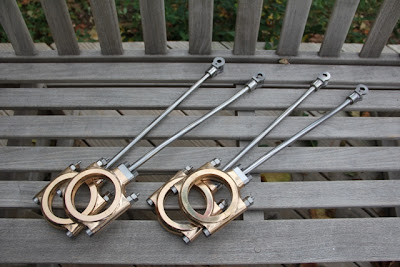I found two great deals on E-bay and finally made a purchase of a VFD and 3-phase motor. The VFD and motor are both 2hp units and this should give me an upgrade over the 1.5hp (questionable Chinese hp) of my mill's current motor as well as a bit more available torque when the drive is a lower RPMs. I'll still need to change the belt location to change within speed ranges as the AC motors tend to overheat when driven too slowly but I should be able to move within the range and fine tune cutting speed with just a turn of the speed potentiometer. The project cost should be under $300 as the VFD and motor were both obtained for under $100 each and I have some other items which picked up for free. I need to purchase control switches and a potentiometer knob (locking with indicator) and some other sundry items before I can start the conversion.
By the way: The motor weighs in at 70lbs. I wonder what the UPS man must be thinking when he stops at my house!
I have also started to whittle down the steel bars that will be the connection rods for the York engine. Spent about five hours in the shop yesterday and ended up with a 5 gallon pail full to the top with swarf and a nicely roughed out chunk of steel. Two pieces are ready for the though bores and finishing to size. The interrupted cut went much better than I had expected. Using the TPG style insert with the tool turned about 30 degrees seemed to reduce the amount of pounding as the tool entered work in a more progressive manner instead of taking the bite all ate once against the edge of the work as it came around to the tool. I only have one holder for this style insert which places the cutting edge perpendicular to the lathe axis hence the need to turn the toolpost.
The photo was taken before the second, now roughed out, part was started. The order of operations so far was to blue one end of the bar and locate then center punch at the center of the bar. I don't have a drill press and the throat of my mill is too small to accommodated the 14" bar on end so I center drilled the end using the cordless drill. The bar was placed in the 4 jaw chuck and on the live center at the tailstock end then the 4 jaw was indicated in to center the axis of the bar. A wide part-off tool was used to plunge in the shoulder at the headstock end. This was to be sure that the round would was running true to the center of the bar since this end was indicated to center in the 4 jaw. The bar was removed then flipped end for end and mounted in the four jaw with the newly formed shoulder placed on the steady rest. The entire part was re-indicated in to be sure it was on axis and aligned along the lathe. The remaining end was center drilled in the lathe. This procedure should help in getting the part centered better than I could have if I had just center drilled the ends by using the cordless drill (or locating and drilling using a drill press). The steady rest was removed and the part returned to center with the live center and indicated at the four jaw as a double check before starting the removal of the material between the flanges. The large end flange will be turned to 3.00" which is the size along the longer end of the stock so taking these extra precautions to get the stock centered will pay off when the flange is machined.
Till next time
Cheers






